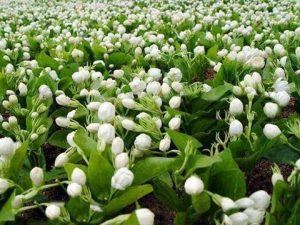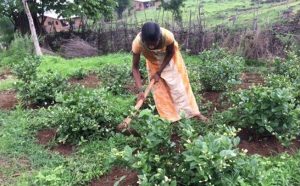Flowers have an immediate impact on our happiness. They bring with them lot of positivity and delight. The fragrance of flowers have a long-term positive effect on our moods. They reduce depression, anxiousness and agitation to a great extent. Flowers make intimate connections, they increasing our connectivity with family and friends. Mogra which is famously known as Jasmine flower is one of the most beautiful and fragrant amongst all flowering plants in Asia. The flower is also referred to as Kundumalligai, Arabian Jasmine, Jai, Jui, Chameli, Madanban, Sayali, Kunda or Mallika. The popularity of Mogra is too high, as it is referred as “Moonshine in the garden.” Shrubs or ramblers, most having highly scented flowers. Mogra bloom in summer and monsoon and some verity blooms in winter.
Mogra is incomparable with any other flower, its five white petals are a tiny box of fragrance. It gives a high to the brain, it buzzes with happiness and serenity. Have them in your garden and see a magical difference. In India, the Mogra flower has a great religious significance; it is known as a favorite flower of Lord Vishnu and Goddess Laxmi. World over it is used in perfumes and medicine. The garlands of the flower are offered to Gods and Indian women wear them in their hair as adornment. The beautiful white flowers have a strong, but pleasant scent that is enduring. The flower itself is very durable, and stays fresh for a long time, even in hot climates. It continues to exude perfume for a day after being plucked.
Mogra is well respected for its medicinal properties and aromatherapies. It is one of the famous flowers used by aroma therapists for its healing and calming influence. The roots and leaves are used in decoctions for relieving sore eyes. The plant is very useful. The common variety of mogra grown on evergreen shrubs, and it is the pride of all gardens. Its botanical name is ‘Jasminum Sambac.’ Some variety of Mogra, such as Jai, Chameli grows on vine; the shrub grows up to 0.5 to 3 mtrs and the vine up to 10 feet.
Cultivation of Mogra plant
In the Summer season preferably from June to November, plant a softwood cutting, semi hard wood cutting or it can be easily done through simple layering. Make sure that it is planted six inches deep inside the soil. Regular watering ensures ongoing life for the plant as it requires moist and well -drained soil to flourish. Proper quantities of manure, good Sunlight and frequent pruning will result in maintaining good health of Mogra plant or vine. Give it a heavy support to climb up to. Do not forget to remove the weeds present near Mogra plants. Keep adding Fertilizers from time to time. For nourishment of the plant Phosphorous and Potassium should be applied in two split doses i.e once after annual pruning and again during June and July. To avoid frequent pruning and to enhance lateral growth pinch the tips of the plants.
Surprisingly, the little flowers that this plant bears in huge clusters is simply about an inch each. The oval shaped green rich leaves, bear around five to nine leaflets which give the entire plant a very beautiful and arty look. By the way, Mogra is a symbol of purity and peace.
Medicinal Uses: The Mogra or Jasmine flower is used as a vital ingredient of almost all ayurvedic medicines owing to its diverse curing qualities. You will be surprised to note that especially it is used to remove intestinal worms. It is also considered to be a suitable and biological cure for jaundice and other venereal diseases. The flower buds help in treatment of ulcers, vesicles, boils, skin diseases and eye disorders. The leaves extracts are useful to stop breast tumors. Do you know that drinking Jasmine tea regularly helps in curing cancer? It is strongly recommended. Jasmine oil is very effective in calming and relaxing.
Jasmine/Mogra is also used for manufacturing perfumes and incense sticks. The flower’s flavor is used extensively in tea. Jasmine tea and other herbal or black tea are famously used all over world. Its oil is also used in creams, shampoos and soaps. It is considered to be a great skin toner and conditioner.
Globally famous: World over Jasmine/Mogra has captured hearts of people. In Philippines it is called ‘Sampaguita’ and its garlands are usually placed on religious images and photographs of the deceased on altars, and is presented to visitors, dignitaries, and occasionally to graduating students as a form of bestowing honor, reverence and accolade. Buds strung into ropes several metres long are often used to decorate formal events. Though edible, the flower is rarely used in cuisine, but in Philippines, one of the ice-creams is flavored with this flower.
In Indonesia Mogra is called ‘Melati Putih’ and it is considered as one of the three national flowers of Indonesia. Mogra was officially adopted as national flower in 1990 during World Environment Day and enforced by law through Presidential Decree No. 4 in 1993.
In Cambodia, the flower is used as an offering to the Buddha. During flowering season which begins in June, Cambodians thread the flower buds onto a wooden needle to be presented to the Buddha.
The Chinese use the flower for making Jasmine Tea, which is consumed in great volumes. And, one of the famous folk song Mo Li Hua is based on the flower, which is a very famous folk song!
In Hawai, the flower is known as Pikake, which is derived from Peacock. Hawaiians are famous to use the flower in all their official decorations.
In Oman the flower is used prominently on a child’s first birthday. Flowers are sprinkled on the child’s head by other children while chanting “hol hol”.
In Sri Lanka it is widely known as Pichcha or gaeta pichcha. The name sithapushpa and katarolu are also used in older texts. The flowers are used in Buddhist temples and in ceremonial garlands.
Jandy Nelson an American author of young adult fiction says “The smell of jasmine makes people tell their secrets.” After all Mogra is as an antidepressant, antiseptic, aphrodisiac and sedative.


















































